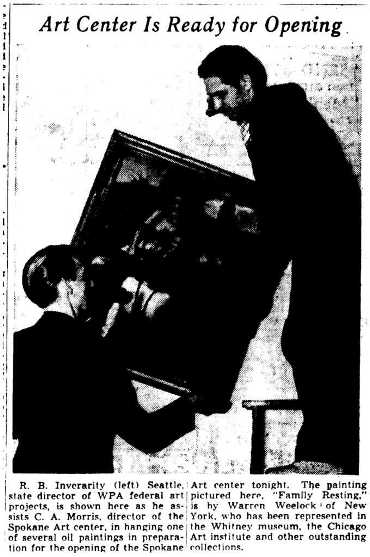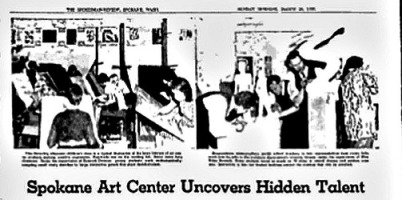
On September, 29, 1938, the Spokesman-Review ran a story on the soon to be opened Spokane Art Center. It highlighted the community's contribution to the project as well as the caliber of work, which would soon be on display for citizens to view free of charge. In the image above, Washington State Federal Art Project Director R. Bruce Inverarity (at left) and Spokane Art Center Director Carl Morris mount a painting by Warren Weelock, an artist from New York. In addition to providing gainful employment to thousands of unemployed artists, the Federal Art Project (FAP) also stressed art education as one of its primary objectives.[1] Prior to the onset of the Great Depression, community-focused art centers, rather than schools dedicated to professional training, were virtually non-existent, particularly outside large cities. Local galleries, especially those featuring work by recognized artists, were also rare, as were lectures and opportunities to learn about art history.
The FAP endeavored to remedy this situation, by making art accessible to the population at-large, “to integrate the fine with the practical arts and, more especially, the arts in general with the daily life of the community.”[2] Culture would no longer be the preserve of wealthy elites; instead, all citizens, whether rich or poor, would have the ability to enjoy and perhaps even partake in artistic production. As historian Victoria Grieve has noted, “[t]he men and women of the FAP had faith in the reconstructive potential of culture and the uplifting values of art, but rejected its status as a sacred realm for the select few.”[3]
Program leaders, including FAP national Director Holger Cahill, firmly believed that direct hands-on experience with the arts would engender greater appreciation and, by extension, a larger market for artistic production among the public, especially in smaller towns and cities removed from urban centers like New York City and Chicago.[4] To this end, the FAP supported the creation of a network of Federal Art Galleries and Community Art Centers across the nation, with the aim of providing Americans an opportunity to view original works of art and to pursue instruction in a wide variety of mediums. FAP administrators articulated their philosophy on art and community in a pamphlet, Federal Sponsored Community Art Centers, issued in October 1937:
The art center program should be directed not only towards building larger audiences for the arts, but also towards guiding and encouraging group activity and group expression leading to more complete community sharing in the experience of art…The project, so far as its personnel and facilities will allow, should endeavor to provide a center for local cultural activities in the visual arts and in related fields.[5]
One of the most successful Community Art Centers established during the New Deal period was the Spokane Art Center in Spokane, Washington. Officially launched on September 29, 1938, as the fiftieth center in the country (Raleigh, North Carolina had the first), it offered more than two dozen courses each week and boasted a monthly visitor count exceeding 2,000 within its first year of operation. Indeed, according to a March 26, 1939 article in the Spokesman-Review, course enrollment alone, equally divided between children and adults, exceeded 800, with another 250 students on the waiting list. [6] Carl Morris, the Center’s Director, commented that, “The types of people benefiting are as various as our approaches, business men and women, clerks, salespeople, nurses, physicians, housewives, laborers, railroad employees, school children, the unemployed – all find relaxation in one or more of the thirty weekly classes.”[7]
Even before its doors opened to the public, the Center enjoyed widespread community support; in fact, the FAP required evidence of strong local backing prior to committing some $12,000 in yearly operating funds to the endeavor. [8] According to National Director Cahill: We are not interested in starting centers unless the community is willing and shows potential resources to carry out an art center of consequence, no matter how small it may be. We are not trying to start temporary art centers solely for the education of under-privileged people. It is our intention to start only active centers, which will develop permanent jobs for artists and art workers and, through this, to develop broad community participation.[9]

In March 1939, the Spokesman-Review dedicated a special two-page feature to the Art Center. The story highlighted the impact that the Center was having on the community, including the depth and breadth of its course offerings. Prominent Spokane citizens established an advisory committee and later a board, committed to raising monies at the outset and yearly, and located a building in the center of town to house the center.[10] These activities built on existing organizations, including an art association, which mounted small exhibits, as well as a group known as the Associated Art Teachers that offered classes, especially to children.[11]
Confirmation of the community’s interest in the Center became obvious during the inaugural fundraising drive. Begun in March 1938 by Daniel Defenbacher, a regional FAP adviser and former State Director for North Carolina, the effort quickly exceeded expectations, reaching its required goal, during the grim days of the Great Depression, in less than two months.[12] “Members of the Art Association, public-school teachers, and leading businessmen were among those who recognized the potentialities of the art center program,” Carl Morris remarked. “This group accepted the responsibility of raising $2,500. Businessmen’s service clubs, the Junior League, women’s organizations, and public-school children cooperated in the drive, which exceeded its goal by $1,000.”[13] No contribution was too small and a percentage of the monies even came from a penny drive conducted in the schools.[14] Donations came in from throughout the community, with no single amount greater than the $200 given by the Junior League.[15] Many of the workers responsible for building the center were themselves on relief, yet they too contributed to the effort, working overtime and without pay in order to ensure that the Center opened on schedule.[16]
The center hoped to began offering classes immediately, but, with only one teacher available and approaching 1,000 interested students , the future appeared uncertain. In response, Morris prevailed upon the national FAP office in Washington, D.C. to send an additional teachers from other, larger art projects.[17] Ultimately, four artists were located from among FAP personnel in New York City and they soon made the trip across the country to begin work in Spokane just as the center opened.[18] Interestingly, as teachers they were still required to continue with their own artistic production and thus remain active in the field even while instructing others.[19]
Morris himself was an interesting selection to head the Center. In a letter to FAP National Director Cahill, the Washington State Director, R. Bruce Inverarity, recommended that the ideal candidate be “a he-man with a bass voice as there is still a bit of the pioneer liking of manliness in Spokane…”[20] Whether Morris qualified as a he-man is unclear, but, according to one scholar, he was “ tall, handsome, and rugged.”[21] Born in 1911, in Yorba Linda, California, he began his art training in high school. After attending Fullerton Junior College from 1930-1931, he moved to Chicago to study painting at that city’s famous Art Institute. He spent three years, 1933-19636, in Vienna and Paris before returning to the United States to work on movie sets in Hollywood. Morris then returned to the Chicago to teach at his alma mater for a year, before accepting the position in Spokane early in 1938.[22]
Like many of the other men and women involved in FAP planning and administration, Morris had high hopes for the Spokane Art Center and for public education in the arts more generally. Rather than an emergency measure that would end when the economy improved, the Art Project and the centers it encouraged would continue as permanent fixtures on the cultural landscape. The Center was “[u]nlimited in its possibilities…,” Morris wrote in the late 1930’s. It “will become important in every phase of educational, industrial, and social constructive growth… It is our task to prove that a casual acquaintance with the arts through occasional lectures or exhibits is insufficient and that only through direct application and participation can the arts have practical use rather than merely provide culture.”
[23]
During its early years, the Spokane Art Center flourished. Staff published a local arts journal that came out about once a month, organized lectures and allowed community groups to have access to the building for meetings.[24] Students and visitors patronized the center and gallery by the thousands, filling classes and viewing traveling exhibits from across the country. For example, in the first five and a half months the center was open, 13,000 visitors came through its doors to see a series of 3-week long shows. However, despite these successes, funding uncertainty plagued the Center as did frequent staff turnover and seemingly arbitrary rule changes stemming from shifting political winds in Washington, D.C.
In addition, local politics proved troublesome, as Morris and his supervisor in Seattle, Inverarity, often clashed with more conservative forces in Spokane, who disapproved of both avant-garde artistic styles and some of the liberal living arrangements (unmarried couples, for example) of Center staff.[25] In addition, Inverarity’s plans to open a widespread network of local galleries throughout Washington State caused disagreements with both national program staff in Washington, D.C. and locals in Spokane, who saw attention and funds shifting away from the initial Community Art Center site. The disagreements reached a crescendo when Morris himself, along with one of the teachers, his future wife Hilda Deutsch, left Spokane to assume new FAP positions in Seattle associated with Inverarity's plans. Angered by these actions, members of the Spokane Art Center Board joined with other critics of Inverarity, including some of Seattle's most influential artists, who had long disliked his management style and questioned his own artistic credentials,, to demand Inverarity's immediate resignation from the FAP program. Ultimately, after an investigation by the national office, Inverarity, with Cahill's somewhat resigned support, survived, remaining in his position until the program ended in 1942.[26]
The center survived after Morris' and Deutsch's departure, but the uncertainty in staffing and in federal funding, stemming from changes in the Works Progress Association (WPA) administration nationally, stalled momentum. The final blow, however, came with the United States’ entry into World War II. Like other communities across the nation, Spokane citizens shifted their volunteer time and discretionary monies towards the war effort. The loss of WPA funds in 1942, which had supported the bulk of operating costs and staff salaries, also proved decisive. In November of thay year, the center closed due to the war, never to reopen in its original format.[27]
Despite internal political wrangling between local residents, FAP administrators in Seattle and the national office, the Spokane Art Center represented a great success for the state and national FAP programs. With only a small staff and budget, the Center was nonetheless able to provide an unparalleled opportunity for the citizens of eastern Washington State to see and partake in art as never before. The Center movement demonstrated that citizens of smaller cities and towns, like Spokane, were eager to experience the visual arts through exhibits, art history courses and even lectures on artistic theory and practice, not to mention the hands-on courses, which appealed to citizens of all ages and skill levels.
From 1936-1942, the Federal Art Project, in partnership with citizens across the nation, supported the development of over a hundred 100 Community Art Centers. During the program’s brief tenure, millions of Americans, including tens of thousands of Washingtonians, took advantage of their local Center’s offerings. Never before had so many residents of so varied geographic, economic and ethnic backgrounds had access to such high quality artistic resources and training. While short-lived and plagued by financial and personnel difficulties, the Spokane Art Center nonetheless stands as a testament to the ingenuity, curiosity and community-mindedness demonstrated of Washington State residents during the dark days of the Great Depression. [28]


